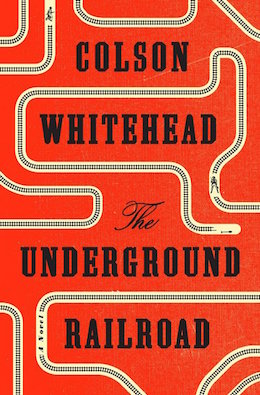Colson Whitehead’s The Underground Railroad is the kind of book I want to shove into people’s hands like an overzealous missionary. I can talk anybody into it, because it’s a book like a diamond: view it through any facet you like and fall slack-jawed at what you see.
Read it one way and it’s a stunning literary work, suitable for academic discussion, shortlisted for the National Book Award. Present it to a true-blue science fiction fan and it’s Philip K. Dick and Octavia Butler’s love child with prose that’ll stop their pulpy heart. Tell a horror reader that it builds dread like a Stephen King classic. Throw on top of that an incredibly skillful first-person narration by a female character handled deftly and authentically by a male writer and you may as well start warming up the baptismal font; the reader is going to convert.
This isn’t exactly a surprise from the author of Zone One or The Intuitionist. Whitehead has been simultaneously racking up genre cred and literary accolades for the better part of two decades. Most writers are either gifted storytellers or good writers. Audiences are willing to forgive terrible deficiencies in one category for even basic competency in the other. Colson Whitehead exists in that golden vesica piscis where the two overlap. The Underground Railroad is a book that sticks to the reader, both because of a compelling, harrowing story and prose that prickles up the back of your neck and makes you hit the “go back 10 seconds” button. (I like audiobooks, ok? This one is great.)
The book follows Cora, a slave on a Georgia plantation who makes a decision to escape and finds her way to the Underground Railroad. In this story, as in all our elementary school imaginations, the railroad is literal rather than figurative. In endless tunnels beneath the earth, Cora rides on trains and handcars to make her escape and keep making it, as no place is truly safe.
Her travels take her to terrifying and tiresome places, including a human diorama that is startlingly funny and sad by turns. The living display puts on a show of life in Africa, the passage of a slave ship, and plantation life for white tourists. It’s a deeply uncomfortable moment for a white reader accustomed to consuming Black pain for entertainment, and I encourage people to sit with that discomfort as Cora describes the way people watch her, the way she is always for sale.
The central conceit, the railroad itself, is everything. It’s the element that wonks this book’s orbit out of the literary rotation and into the genre belt. It’s an extended metaphor and an iron and coal reality. It’s the only way to see America: staring out an empty window hole into day-long stretches of windy darkness, moving from the past into the somewhat brighter future. Most importantly, on my third read of this novel, I realized that it’s also about the creative process and the way that it changes the artist.
Cora asks the first person who shows her the railroad, “Who built this?” And the answer is, “Who built everything in this country?” Cora accepts that as obviously true at first, but she begins to think about the labor of slaves and what it changes, as well as how it changes them; how labor changes the laborer in every sense. This is it. This is the most awesome moment in an awesome book, when Cora thinks it out:
“Who are you after you finish something this magnificent—in constructing it you have also journeyed through it, to the other side. On one end there was who you were before you went underground, and on the other end a new person steps out into the light. The up-top world must be so ordinary compared to the miracle beneath, the miracle you made with your sweat and blood. The secret triumph you keep in your heart.”
Every creative endeavor is that secret triumph. To be clear, The Underground Railroad does not openly equate the art of writing with the stolen labor of slaves, but it does bring to mind how both transform the self. When you read a book, but even more so when you write one, you journey through. You ride the train while laying down the tracks just ahead of yourself. When you finish, it is newly created and you are someone else. A story like this is that miracle of sweat and blood; Whitehead has made it so that people can discover something they thought was a legend and ride it for themselves.
Who are you after you finish something this magnificent?
 Meg Elison is a Bay Area author and essayist. Her debut novel The Book of the Unnamed Midwife won the 2014 Philip K. Dick Award and has just been reissued from 47North. Her second novel, The Book of Etta, will be published in spring 2017 by 47North. Her work has appeared in The Establishment, Liquid Imagination, Compelling Science Fiction, Everyday Feminism, and many other places online and in print. Find her on Twitter @megelison.
Meg Elison is a Bay Area author and essayist. Her debut novel The Book of the Unnamed Midwife won the 2014 Philip K. Dick Award and has just been reissued from 47North. Her second novel, The Book of Etta, will be published in spring 2017 by 47North. Her work has appeared in The Establishment, Liquid Imagination, Compelling Science Fiction, Everyday Feminism, and many other places online and in print. Find her on Twitter @megelison.










